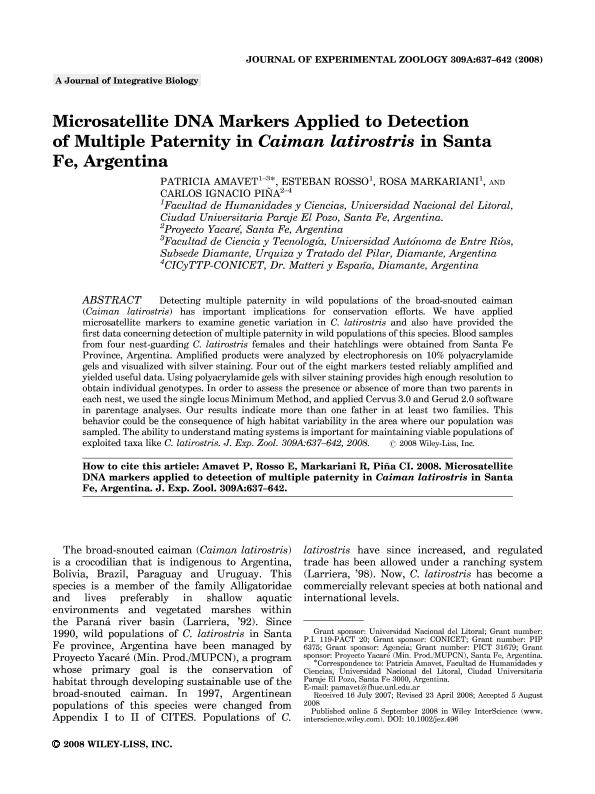Artículo
Microsatellite DNA markers applied to detection of multiple paternity in Caiman latirostris in Santa Fe, Argentina
Fecha de publicación:
12/2008
Editorial:
Wiley-liss, Div John Wiley & Sons Inc
Revista:
Journal of Experimental Zoology Part A: Ecological Genetics and Physiology
ISSN:
1932-5223
Idioma:
Inglés
Tipo de recurso:
Artículo publicado
Clasificación temática:
Resumen
Detecting multiple paternity in wild populations of the broad-snouted caiman (Caiman latirostris) has important implications for conservation efforts. We have applied microsatellite markers to examine genetic variation in C. latirostris and also have provided the first data concerning detection of multiple paternity in wild populations of this species. Blood samples from four nest-guarding C. latirostris females and their hatchlings were obtained from Santa Fe Province, Argentina. Amplified products were analyzed by electrophoresis on 10% polyacrylamide gels and visualized with silver staining. Four out of the eight markers tested reliably amplified and yielded useful data. Using polyacrylamide gels with silver staining provides high enough resolution to obtain individual genotypes. In order to assess the presence or absence of more than two parents in each nest, we used the single locus Minimum Method, and applied Cervus 3.0 and Gerud 2.0 software in parentage analyses. Our results indicate more than one father in at least two families. This behavior could be the consequence of high habitat variability in the area where our population was sampled. The ability to understand mating systems is important for maintaining viable populations of exploited taxa like C. latirostris.
Palabras clave:
Caiman Latirostris
,
Mating System
,
Multiple Paternity
,
Molecular Markers
Archivos asociados
Licencia
Identificadores
Colecciones
Articulos(CCT - SANTA FE)
Articulos de CTRO.CIENTIFICO TECNOL.CONICET - SANTA FE
Articulos de CTRO.CIENTIFICO TECNOL.CONICET - SANTA FE
Articulos(CICYTTP)
Articulos de CENTRO DE INV.CIENT.Y TRANSFERENCIA TEC A LA PROD
Articulos de CENTRO DE INV.CIENT.Y TRANSFERENCIA TEC A LA PROD
Citación
Amavet, Patricia Susana; Rosso, Esteban; Markariani, Rosa; Piña, Carlos Ignacio; Microsatellite DNA markers applied to detection of multiple paternity in Caiman latirostris in Santa Fe, Argentina; Wiley-liss, Div John Wiley & Sons Inc; Journal of Experimental Zoology Part A: Ecological Genetics and Physiology; 309A; 10; 12-2008; 637-642
Compartir
Altmétricas




